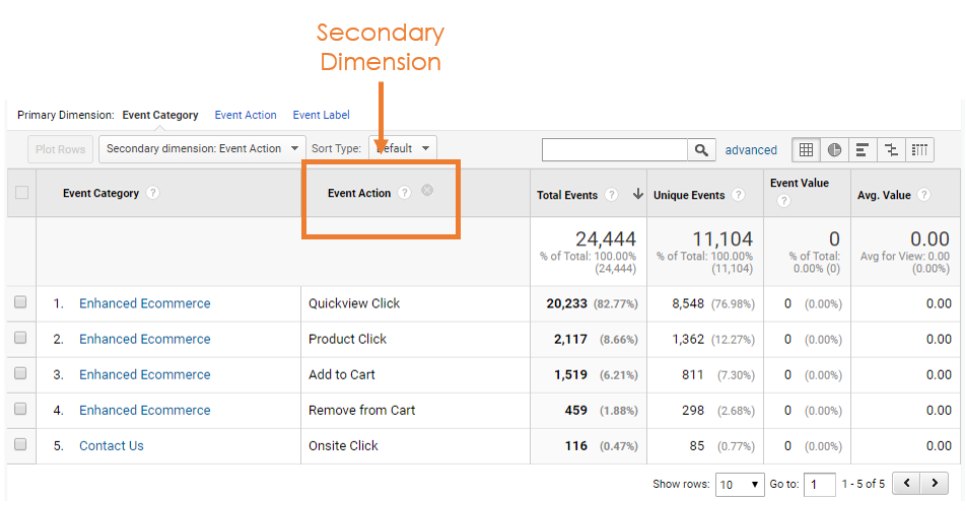Utilizing Secondary Dimension in Google Analytics for Boosted Coverage
Utilizing Secondary Dimension in Google Analytics for Boosted Coverage
Blog Article
Opening the Power of Additional Measurement Analytics for Enhanced Information Insights and Decision-Making
In the realm of data analytics, key dimensions typically take the limelight, yet truth depth of understandings lies within the realm of additional measurements. These additional data factors supply a nuanced perspective that can light up partnerships and patterns not readily obvious initially look. By utilizing the power of additional measurement analytics, companies can introduce hidden trends, discover connections, and remove extra purposeful conclusions from their data. The potential for improved decision-making with the application of these second dimensions is large, guaranteeing a much deeper understanding of intricate information collections and leading the way for even more enlightened strategic choices.
Significance of Secondary Measurements
Discovering the relevance of additional dimensions in analytics unveils the surprise layers of information insights essential for informed decision-making in numerous domains. Secondary measurements supply a deeper understanding of primary information by supplying extra context and point of views. By incorporating second measurements into analytics, organizations can remove a lot more extensive and nuanced understandings from their datasets.
One secret value of additional measurements is their capability to segment and categorize main information, permitting a much more thorough evaluation of specific parts within a dataset. This segmentation makes it possible for services to identify patterns, patterns, and outliers that might not appear when taking a look at the information overall. Furthermore, second dimensions assist in revealing correlations and reliances in between different variables, causing even more accurate forecasting and anticipating modeling.
In addition, secondary dimensions play a vital duty in enhancing data visualization and reporting. By including second measurements to visualizations, such as charts or graphs, analysts can produce a lot more informative and insightful depictions of information, facilitating better communication of findings to stakeholders. Generally, the combination of second measurements in analytics contributes in opening the complete possibility of information and driving evidence-based decision-making.
Trick Advantages of Making Use Of Second Measurements
Utilizing second measurements in analytics offers companies a calculated advantage by boosting the depth and granularity of data understandings. By dissecting information utilizing secondary measurements such as time, place, device kind, or user demographics, companies can discover patterns, trends, and relationships that may or else continue to be covert.
In addition, the usage of additional measurements boosts the context in which primary data is translated. By leveraging additional measurements in analytics, companies can harness the complete potential of their data to drive better decision-making and accomplish their service purposes.
Advanced Information Evaluation Techniques
A deep study sophisticated data analysis methods exposes innovative approaches for removing beneficial understandings from complex datasets. One such technique is machine knowing, where algorithms are employed to identify patterns within data, predict outcomes, and make data-driven decisions. This approach enables the automation of logical version structure, making it possible for the handling of big quantities of data at a quicker pace than traditional methods.
Another innovative strategy is anticipating analytics, which makes use of analytical algorithms and artificial intelligence techniques to anticipate future end results based on historical information. By assessing fads and patterns, companies can anticipate consumer actions, market patterns, and potential risks, empowering them to make aggressive decisions.
Additionally, text mining and view evaluation are important techniques for removing insights from unstructured information sources such as social media comments, consumer testimonials, and study reactions. By evaluating text data, companies can comprehend customer point of views, determine emerging fads, and enhance their service or products based upon comments.
Enhancing Decision-Making Via Additional Dimensions

Enhancing decision-making via secondary measurements allows organizations to make more informed and targeted critical selections. By segmenting customer data based on additional measurements like acquiring background or involvement levels, companies can tailor their advertising methods to certain target market sectors, leading to boosted conversion prices and consumer satisfaction. Furthermore, additional dimensions can help determine connections and connections between different variables, enabling organizations to make data-driven decisions that drive growth and profitability.
Applying Second Measurement Analytics
When integrating additional dimensions in analytics, companies can open much deeper insights that drive strategic decision-making and boost total efficiency. Executing secondary measurement analytics calls for a structured method to ensure reliable go right here use of this powerful tool. The very first step is to identify the vital metrics and measurements that align with the company's calculated goals. This entails recognizing the particular questions the company seeks to address and the data points needed to address them.

Moreover, companies ought to utilize advanced analytics devices and modern technologies to improve the procedure of incorporating additional measurements. These tools can automate data handling, evaluation, and visualization, allowing companies to concentrate on interpreting insights instead of hand-operated data control.
Verdict
In conclusion, secondary measurement analytics play a crucial role in improving information understandings and decision-making procedures. By utilizing sophisticated information evaluation strategies and implementing secondary dimensions successfully, companies can open the power of their information to drive strategic business decisions. The essential advantages of making use of second measurements can not be overstated, as they offer a deeper understanding of data trends and connections. It is vital for companies to take advantage of second measurement analytics to remain affordable in today's data-driven landscape.
In the realm of data analytics, main dimensions typically take the spotlight, yet the true depth of understandings lies within the realm of additional measurements.Making use of additional measurements in analytics provides companies a calculated benefit by augmenting the depth and granularity of data understandings. By leveraging second dimensions in analytics, companies can harness the complete capacity of their data to drive far better decision-making and accomplish their business purposes.
Applying data recognition procedures and regular audits can aid preserve data top quality and dependability.
By utilizing innovative data evaluation methods and implementing second dimensions properly, companies can unlock the power of their information to drive tactical business choices.
Report this page